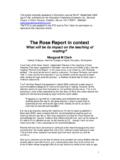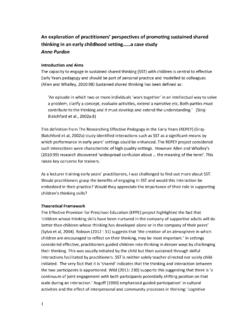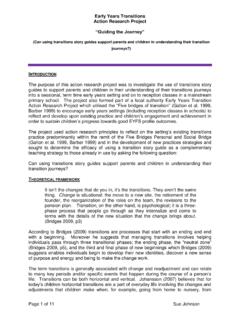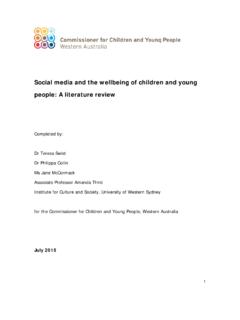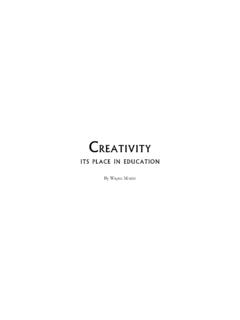Transcription of Creativity and Possibility in the Early Years - tactyc.org.uk
1 Creativity and Possibility in the Early Years Professor Anna Craft University of Exeter and The Open University Introduction Fostering children 's Creativity involves more than resourcing the creative corner' in our classroom spaces. As the new Early Years Foundation Stage (EYFS: DfES 2007) which comes into force in all Early Years settings from September 2008 makes clear, nurturing children 's Creativity involves close scrutiny of processes of meaning-construction for each learner, recognizing the sheer creative engagement manifest by young learners, as they move beyond the given, or what is', to the possible, or to what could be'.
2 It involves, in other words, what might be called Possibility thinking', which is what this short article explores. Possibility as the core of Creativity I have long argued that Possibility thinking' is at the heart of all Creativity in young children , whether they are working alone, in parallel or in collaboration with others. Possibilities are generated by children (and adults) in all areas of learning, whether imaginative play, musical exploration and composition, cooking, mark-making or writing, outdoor physical play, mathematical development or Early scientific enquiry.
3 Possibility thinking is the means by which questions are posed or puzzles surfaced through multiple ways of generating the question what if?' (Craft 2000; 2001; 2002). What if?' may be experienced unconsciously in the flow of engagement (for example, in a two-year-old realising that, in crawling through the long grass, it starts to make a track'; in an eight-year-old realising that a number pattern can be made in following the 9x table, or in a pair of three-year-olds making soup' from daisy petals). Possibility thinking, then, essentially involves a transition in understanding; in other words, the shift from What is this?
4 ' to exploration What can I/we do with this?' Fostering Possibility children involves enabling children to find and refine problems as well as to solve them. This distinction between finding and solving problems has been explored through studies in primary classrooms (Jeffrey 2004;. 2005; Jeffrey and Craft 2004). Fostering children 's Possibility thinking can be seen as building their resilience and confidence and reinforcing their capabilities as confident explorers, meaning-makers and decision-makers. In recent Years , it has become a focus of policy development for education 1.
5 In many parts of the world. This in turn has impacted policy for Early Years education and care. In England, 1999 can be seen as a turning point in policy-making on Creativity . In that year, the National Advisory Committee for Creative and Cultural Education (NACCCE 1999). advocated that alongside having high standards of academic achievement, young people now needed to leave formal education able to adapt, see connections, innovate, communicate and work with others' (ibid:13). Concrete proposals in the NACCCE Report provided a foundation for educational policy moves in England, including the codifying of Creative Development into the Early Years curriculum for three-to-five-year olds in 2000 and, later, the complete review of the curriculum for birth-five-year olds leading to a seamless care and education policy in which Creativity was to play a key role (DfES 2007).
6 As well as impacting on curriculum development, the NACCCE Report influenced shifts in the wider policy agenda which, in turn, influenced Early childhood education, such as the introduction of Every Child Matters from 2003 (Every Child Matters 2004a), designed to ensure the well-being of children and young people from birth-to-19 Years , by supporting the development of resilience and resourcefulness (Craft 2005). It also led to focused engagement by policy makers and policy advisers, such as the establishment of The Qualifications and Curriculum Authority Creativity Project (QCA 2005a; 2005b), also the publishing of Excellence and Enjoyment for primary schools in May 2003 (DfES 2003), exhorting primary schools to take creative and innovative approaches to the curriculum and to place Creativity high on their agendas, followed by materials to encourage this (DfES 2004b).
7 In late 2005 and Early 2006, a further government review of Creativity and the economy was undertaken (Roberts 2006). These wide ranging policy initiatives in England have focused on all phases of education from the Early Years through to higher education. Common to them all is the commitment to the idea of little c' Creativity (Craft 2000; 2001; 2002), in other words, everyday, lifewide Creativity . There is a democratic assumption built in to much policy work following on from the NACCCE. Report (1999) which suggested that we are all capable of creative engagement and that all learning involves elements of Creativity .
8 Creative practice and practice which fosters Creativity In her work on Creativity with babies and toddlers, Tina Bruce proposes the idea of cultivating'. Creativity , emphasising the role of adults in supporting rather than imposing. This acknowledges the vital role that adults play in the Early Years . Bruce argues that, without sensitive engagement with children and with their families, emergent possibilities for Creativity that are in every child do not develop or can be quickly extinguished' (Bruce 2004:12). 2. There is an equally compelling case for the ways we work with older children .
9 Adults in Early Years settings have multiple opportunities to develop practice so as to foster children 's Creativity , focusing on each child's motivations and interests and, in valuing and appreciating these, encouraging exploration without invading the child's creative idea or taking it over'. (Bruce 2004: 25). As Beetlestone (1998) and Duffy (2006) remind us, Creativity is relevant across all aspects of learning; it is as relevant in imaginative play as it is in solving a dispute or generating ideas in mark-making. It is as relevant in making the next game come up on the computer, as it is in exploring textures in paint, dried pasta and sand.
10 It is important to distinguish between creative practice and practice which fosters Creativity . In developing creative practice, we are nurturing imaginative approaches to how we work with children . In practice which fosters Creativity by contrast our focus is mainly on ensuring that we encourage children 's ideas and possibilities, and that these are not suffocated (Jeffrey and Craft 2003; Craft and Jeffrey 2004). Studies suggest that practice which fosters Creativity can be seen as being learner inclusive', in taking children 's ideas seriously.

